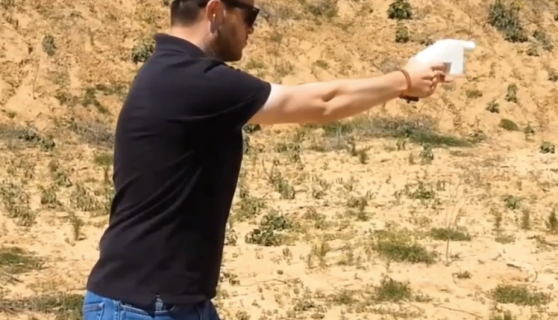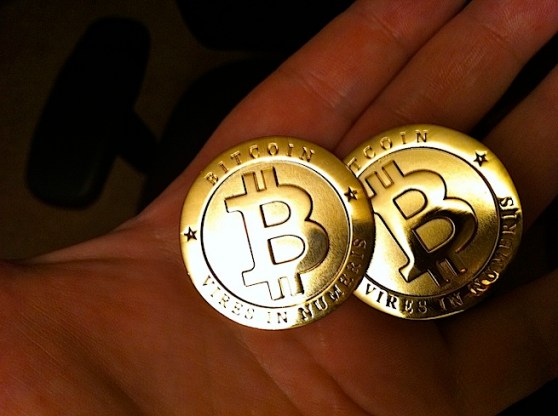Cody R. Wilson is disappointed.
Sitting in front of him at a conference in New York City are fifty or so 3D printing enthusiasts, investors, and reporters, all of whom are eager to hear what the face of the 3D printed gun movement has to say about his dangerous new pastime.
But there’s one problem: The room is half empty. Wilson was expecting more interest, more animosity.
“This is bizarre to me. I’ll have to think about what this means,” Wilson said at the podium, mostly to himself.
Wilson’s disappointment is perhaps understandable: Over the past year, the 25 year-old law student has become the face of the budding, controversial 3D-printed gun movement. Reception to this, however, has been less than positive. Wilson’s exploits have not only upset those in the 3D printing world, but they’ve also been severe enough to warrant death threats, questioning from the U.S. government, and a persistent concern that he may one day have to flee the country.
Like most troublemakers, Cody Wilson lives for the fight and the controversy (though the more cynical take is that just likes the attention).”I want that feeling of opposition. That animates me,” he told me.
That opposition is in great supply these days. Earlier this week, Wilson unveiled the Liberator, the first gun created entirely with a 3D printer. The gun’s only metal components are its firing pin and a slug of steel designed to set off metal detectors.
Within hours of the news,Rep. Steve Israel (D-N.Y.) responded, writing a letter expressing his distaste for what Wilson had created.
“When I started talking about the issue of plastic firearms months ago, I was told the idea of a plastic gun is science fiction. Now that this technology is proven, we need to act now to extend the ban [on] plastic firearms,” Israel said.
Israel wasn’t alone. Days later, Sen. Chuck Schumer (D-N.Y.) also chimed in, confirming that he would support legislation to ban 3D-printed firearms.
The worst of the opposition came just a few days ago, when the U.S. State Department’s Office of Defense Trade Compliance ordered Wilson to remove the Liberator design files from his site. Wilson, however, didn’t seem too perturbed: The files had already been downloaded over 100,000 times. They were everywhere.
“Because the files are all over the Internet, the Pirate Bay has it — to think this can be stopped in any meaningful way is to misunderstand what the future of distributive technologies is about,” Wilson told BetaBeat.
The U.S. government still isn’t letting Defense Distributed host the files, but Cody Wilson’s mission to distribute them is already complete.
3D printing your way to freedom
While much of the talk on Defense Distributed focuses on firearms, Wilson says the effort is about so much more. “This project is a way for me to do everything I was ever interested in all at the same time. I want to represent this position in a very pure, forceful way, and I think we did it,” he said.
To understand that position, you first have to understand the idea of “crypto-anarchy,” which holds that the most effective route to political freedom is a combination of unhindered access to information protected by the hard math of cryptography. Wilson, a crypto-anarchist himself, argues that everyone has a right to download their own firearms regardless of how many governmental bodies say they shouldn’t.

Above: Cody Wilson, a known troublemaker, lives to create headaches for regulators. (Photo: Ricardo Bilton/VentureBeat)
That’s where 3D printers come in. Because the technology enables us to digitize and replicate physical objects, 3D printers give crypto-anarchists (or even just gun enthusiasts) a powerful new tool to circumvent governmental control: Once people digitize and disseminate 3D gun files, it becomes a lot harder for law enforcement to regulate them — which is exactly Wilson’s goal. Defense Distributed is blurring the line between gun regulation and censorship by making guns information rather than just objects.
The 3D-printed gun movement isn’t about guns, then, but about what guns represent. As Wilson noted in a Reddit AMA last month, guns are soaked with symbolism.“Printed guns aren’t even proven technology and are extremely impractical devices from my experience. But there is a symbolic advantage to the individual in being at least capable of printing one,” he said.
Click, print, kill?
Keep in mind that we’re talking about guns here. Is Wilson prepared for the possibility of someone one day using his inventions to kill?
”I recognize that this tool might be used to harm people. That’s what it is — it’s a gun,” he told Forbes this week. While that isn’t the most morally sound stance, it’s clear that Wilson is beyond concerns over the harm his inventions could cause.
More, Wilson doesn’t argue against claims that his project will give people increased access to guns because giving people increased access to guns — digital or otherwise– is his organization’s mission:
“[Defense Distributed’s goal is] to defend the civil liberty of popular access to arms as guaranteed by the United States Constitution and affirmed by the United States Supreme Court, through facilitating global access to, and the collaborative production of, information and knowledge related to the 3D printing of arms; and to publish and distribute, at no cost to the public, such information and knowledge in promotion of the public interest.”
Here’s the reality: Anyone who’s really looking to get their hands on a gun already has more than a few options at their disposal — including CNC-milled firearms, $2 dollar zip guns, and AK-47s created with garden shovel parts. 3D printing really isn’t giving the bad guys of the world anything they didn’t already have access to. But the tech could make procurement easier.
“This technology would probably not increase total access but rather the convenience in procuring some type of gun,” RJ Miller, a 3D-printed gun enthusiast told me.
Right now, though, 3D printing a gun is anything but easy. While getting your hands on a gun design file is as simple as a few mouse clicks, actually printing that file is almost the complete opposite, as The Atlantic’s Phillip Bump extensively details.
It won’t always be that way, of course. 3D printers are becoming more common, and Wilson is already working on improvements to the Liberator — so all of this bound to get easier. As much as politicians and gun regulation proponents hate to hear it, what Defense Distributed is working on is going to be really difficult to stop.
Gunning for the future
Defense Distributed, at its core, isn’t just a technical exercise in the possibilities of 3D printing; it’s a political statement meant to show governments how technology can disrupt their capability to create and enforce laws. 3D-printed guns are Wilson’s answer to Wikileaks and Bitcoin: He wants to use information to engineer both freedom and governmental impotence regardless of the possibility that bad guys will do the same.
“If we begin second-guessing every potential illicit use of a technology and restricting it from the outset because of fear, we’re not going to progress as a society,” said Michael Guslik (aka Have Blue), the mind behind the original 3D-printed lower receiver design.
The 3D-printed gun movement also means a lot to 3D printing itself, as it takes the technology’s “make anything” imperative and pushes it to its most logical extreme: If 3D printers can create whatever you think up, why not create a gun, a sex toy, or even a car?
“Why would I run a 3D printer if I can’t make the things that are worth making? 3D printing is all about unintended uses,” Wilson said.
And if all of this talk about guns is too glum for you, just know that these “unintended uses” extend beyond that of dangerous objects like firearms. Seeing as some people are printing out prosthetic hands for kids, it’s clear that 3D printing enthusiasts can take take the technology just about wherever their minds go.
Cody R. Wilson’s mind just took him to guns.




